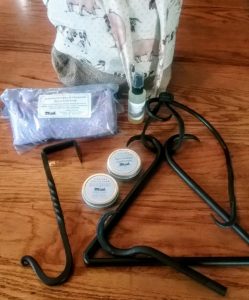Have you heard of Etsy? It is an online marketplace where vendors can sell handmade and/or vintage goods. Selling on Etsy has lots of benefits for us. It has a lot of name recognition and has been around long enough to be a publicly-traded company. Lots of lifestyle magazines feature products found on the site. It can be easily searched. It has an easy-to-use format to create listings of the items we make. While I used to run my own storefront on our farm’s website through Paypal, it was very time-consuming, and individual product listings had to be redone almost from scratch every time I wanted to make an update. Etsy does a good job of keeping it user-friendly, and can be done on a desktop computer at etsy.com, or on my smartphone with the free Sell on Etsy app.
You can sell a wide variety of products on Etsy, although they must be handmade by you or vintage. We offer hand-forged metal work my husband creates in the forge on our farm, as well as my handmade jewelry, herbal salves, natural body care items like sunscreen & lip balms, and sewn items like aprons and totes. I sometimes offer canned goods like jellies, salsas and more, but Etsy does require you to be a licensed kitchen. (That is not a problem for us as we are already regulated & inspected by the Pennsylvania Department of Agriculture to make and sell these things at the farm stand.) We also offer select vintage items, although it isn’t our main focus. Other folks offer home décor, pottery, art, clothing, soap, woodworking, candles, baby items and more. If you can make it, there is most likely an Etsy category for it. You can even sell raw crafting supplies, such as leather, feathers, fur, wool, and so on.

We offer hand-forged metal work, natural body care items, handmade totes and neck pillows and more in our online shop.
Etsy’s fees are pretty reasonable. You’re charged $0.20 to list an item, but that listing is valid for four months. If/when your item sells, you’ll be charged a 3.5% commission and a 3% + $0.25 payment processing fee. We found that these fees are lower than local consignment shops.
Selling online does mean you’ll need to ship your item, but Etsy makes this pretty easy as well. If you enter the item’s weight and dimensions, Etsy will calculate the shipping for you based on the buyer’s zip code. (Be sure to check out my post on using the USPS for lots more shipping tips!) You can also manually set your shipping fees, but in general I recommend letting Etsy’s program calculate it for you. You have the option of shipping via USPS or FedEx right from Etsy, and you get a bit of a discount on the postage if printed through your shop. Printing shipping from your shop also means Etsy will take care of notifying the buyer that the item is shipping and provide them with the tracking number.
The biggest downside to Etsy is that it can be hard to get noticed. This is especially true when you first open your shop. Etsy has a social-media component, where people can “favorite” an item, or your entire shop. You can also follow individuals so you can see what treasures they come across. The more favorites an item gets, the more it can be seen by potential buyers. My advice is to list a number of items when you start, not just a couple. It also helps to embed links in each listing to your main shop page so people can easily see what else you’re making. You’ll also find that the more sales you have, and the more positive reviews are posted, the more the ball will keep rolling for you. Sharing with your friends and followers on social media can also help boost traffic to your listings.
Ads for your products are another way to get noticed. Etsy will walk you through paid advertisement on their site. You can select your daily budget, as well as which of your items to feature. You can choose to feature only some items, or everything in your shop. You can also advertise on Google Shopping through Etsy. This allows you to reach anyone who may be searching Google for products similar to what you’re offering.
When I opened our Etsy shop, Dan was a beginning blacksmith and hesitant to sell his work. The shop made $25 that first holiday season, but I paid out more money in fees than I earned after a period of months. I took it offline. However, I decided to give it another shot as Etsy became more of a household name. Dan agreed to list a few of his creations. Our sales were a couple hundred dollars the next year. I have put a lot of effort into making it a success, from revising photos and listing to offering more and more handmade creations. Like most things, the more effort you put into it, the better your chances for success. It added thousands to the farm’s bottom line last year and continues to grow into a real source of income for us. We’re on track to have a 5-figure income from our Etsy shop this year, which is quite exciting!
Be sure to check back soon, as I’ll be posting a Part 2 about connecting with potential Etsy buyers!










